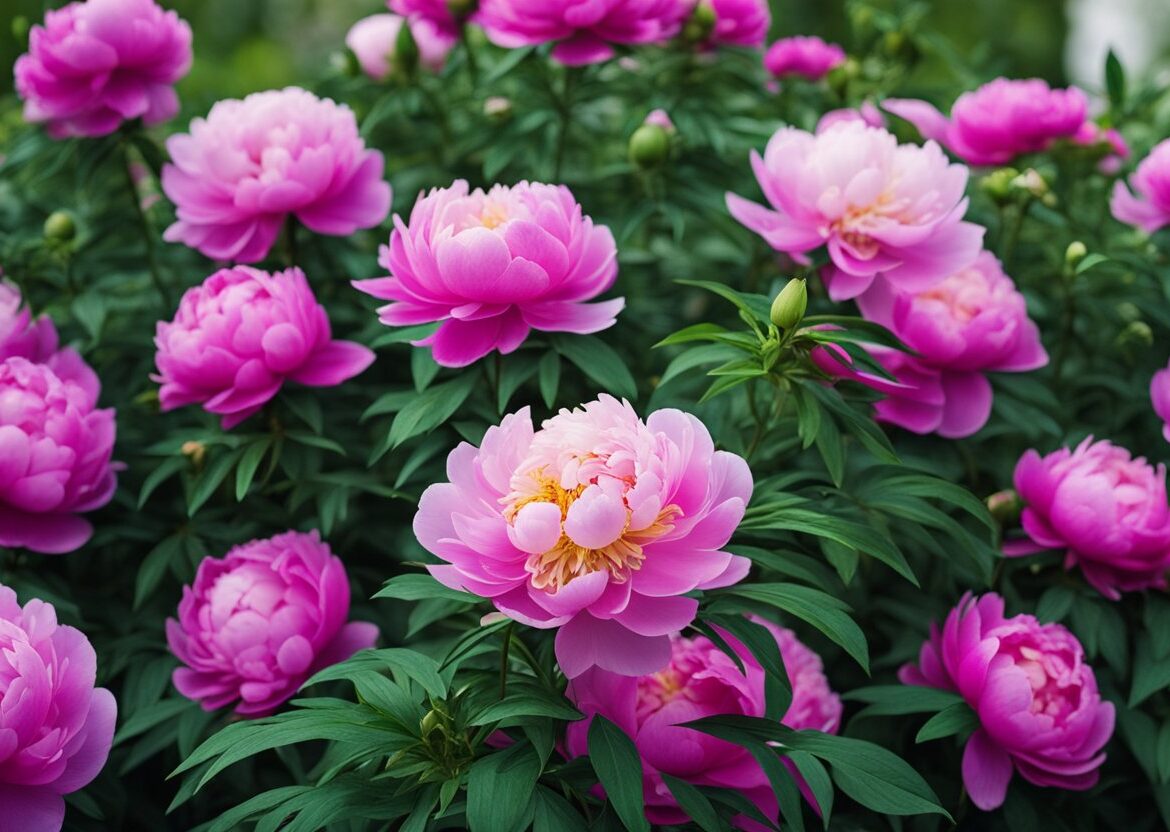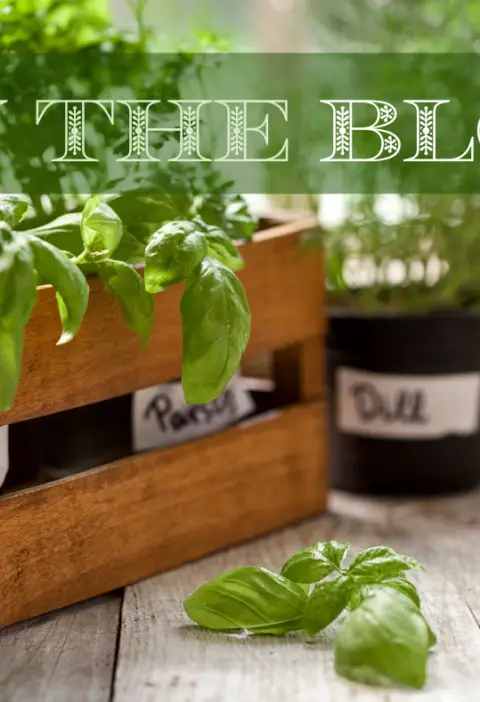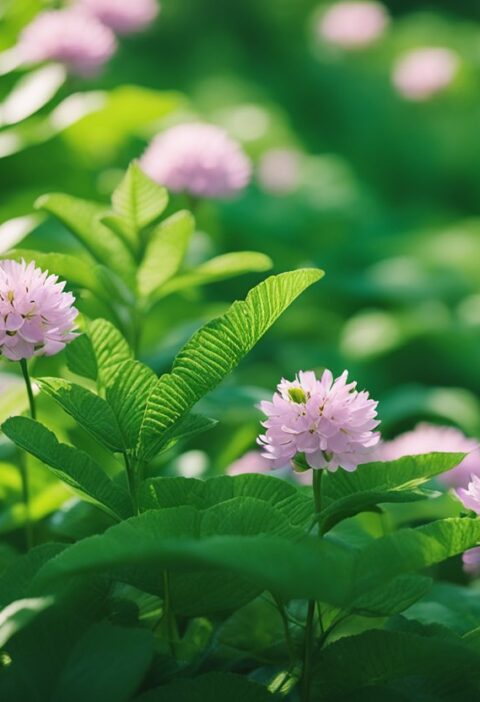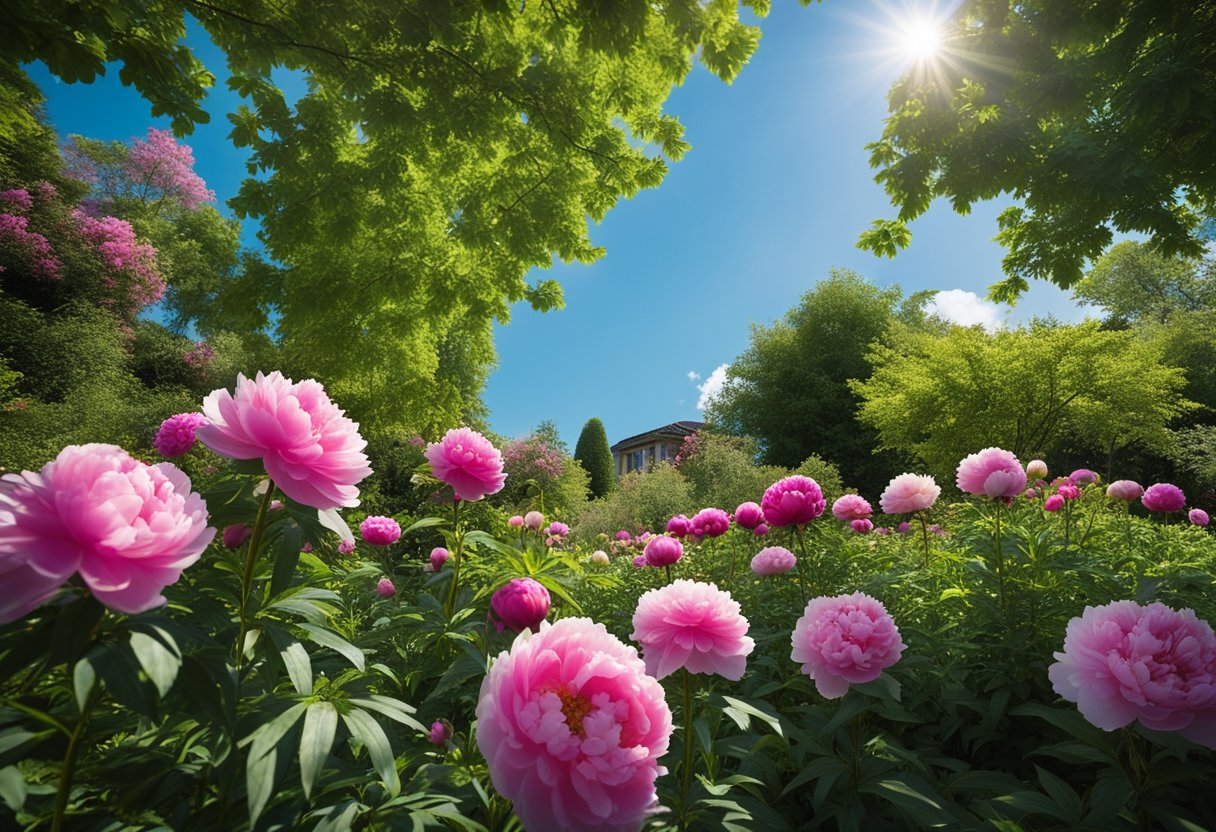
Peonies are one of the most beloved flowers in the world. They are known for their large, fragrant blooms and their ability to thrive in a variety of climates. However, growing peonies that bloom for decades can be a challenge for many gardeners. In this article, I will share my tips for growing peonies that will provide you with beautiful blooms year after year.

First and foremost, it is important to choose the right location for your peonies. These plants prefer well-draining soil and a location that receives at least 6 hours of sunlight each day. Avoid planting them in areas that are prone to flooding or that receive too much shade. Additionally, make sure to provide your peonies with plenty of space to grow and spread out. Crowding can lead to poor blooming and disease.
Secondly, proper care and maintenance are crucial for growing healthy peonies. Regular watering, fertilization, and pruning can make a big difference in the longevity and quality of your blooms. It is important to water your peonies deeply and regularly, especially during dry spells. Fertilize them in the early spring and again after they have finished blooming. Finally, prune your peonies in the fall to remove any dead or diseased foliage and to promote healthy growth in the spring. By following these simple steps, you can enjoy beautiful peonies that will bloom for decades to come.
Understanding Peonies

Peony Varieties
Peonies are herbaceous perennials that are available in a wide range of varieties, each with its own unique characteristics. The most common types of peonies are the herbaceous, intersectional, and tree peonies. Herbaceous peonies are the most popular and widely grown type, with large, showy flowers and a variety of colors, including white, pink, red, and yellow. Intersectional peonies, also known as Itoh peonies, are a hybrid of herbaceous and tree peonies, and are known for their large, long-lasting blooms. Tree peonies are woody shrubs that produce large, fragrant flowers in shades of pink, purple, and red.
Biology of Peonies
Peonies are known for their large, showy flowers, but they also have an interesting biology. Peonies are native to Asia, Europe, and North America, and are grown for their ornamental value. They are a member of the Paeoniaceae family, and are classified as herbaceous perennials. Peonies have a unique life cycle that includes a dormant period during the winter months, followed by a period of growth and flowering in the spring and summer.
History and Significance
Peonies have a rich history and cultural significance. In China, peonies are known as the “king of flowers” and are a symbol of wealth, honor, and prosperity. In Japan, peonies are associated with the samurai culture and are often depicted in art and literature. In Europe, peonies were popularized during the Victorian era and were often used in gardens and floral arrangements. Today, peonies are still a popular flower and are grown for their beauty and ornamental value. With proper care and maintenance, peonies can bloom for decades, making them a valuable addition to any garden or landscape.
Site Selection and Preparation

Choosing the Right Location
When it comes to growing peonies, choosing the right location is crucial. Peonies require a location that receives at least 6 hours of direct sunlight daily. Therefore, it is best to choose a site that is not shaded by trees or buildings.
Peonies also need good air circulation to prevent diseases, so avoid planting them in low-lying areas where the air is stagnant. Additionally, it is important to choose a location that is not prone to flooding or standing water, as this can lead to root rot and other issues.
Soil Requirements and Improvement
Peonies prefer well-draining soil that is rich in organic matter. Before planting, it is important to prepare the soil properly. Start by removing any weeds or debris from the planting area.
Next, amend the soil with compost or well-rotted manure to improve its texture and fertility. Peonies prefer a slightly acidic soil with a pH between 6.0 and 7.0. If necessary, adjust the pH using lime or sulfur according to soil test results.
It is important to avoid planting peonies too deep, as this can lead to poor blooming and weak growth. The eyes, or growing points, should be planted no more than 2 inches below the soil surface. Finally, water the newly planted peonies thoroughly and continue to water regularly until they become established.
Planting Peonies

Peonies are a popular perennial flower that can bloom for decades with proper care. Here are some tips on how to plant peonies to ensure they thrive in your garden.
Best Planting Times
The best time to plant peonies is in the fall, between late September and early November. This allows the roots to establish before the winter frost sets in. However, if you missed the fall planting window, you can also plant peonies in the spring as soon as the ground thaws.
Planting Techniques
When planting peonies, it’s important to choose a location that receives at least 6 hours of sunlight per day and has well-draining soil. Here’s how to plant peonies:
- Dig a hole that is twice as wide as the peony root and deep enough to accommodate the entire root system.
- Mix compost or aged manure with the soil and place a layer of the mixture at the bottom of the hole.
- Place the peony root in the hole with the eyes facing up. The eyes are the small, pinkish buds on the root.
- Fill the hole with the soil mixture and water thoroughly.
Root Division and Planting Depth
If you’re transplanting peonies from another location or dividing an existing plant, it’s important to plant them at the proper depth. Here’s how to plant peonies from root divisions:
- Dig up the entire peony plant and gently shake off the soil to expose the root system.
- Use a sharp, clean knife to divide the root system into smaller sections, making sure each section has at least 3-5 eyes.
- Plant each section into a prepared hole, making sure the eyes are no more than 2 inches below the soil surface.
- Water thoroughly and mulch around the base of the plant to retain moisture.
By following these planting techniques, you can ensure that your peonies will thrive and bloom for decades to come.
Caring for Peonies
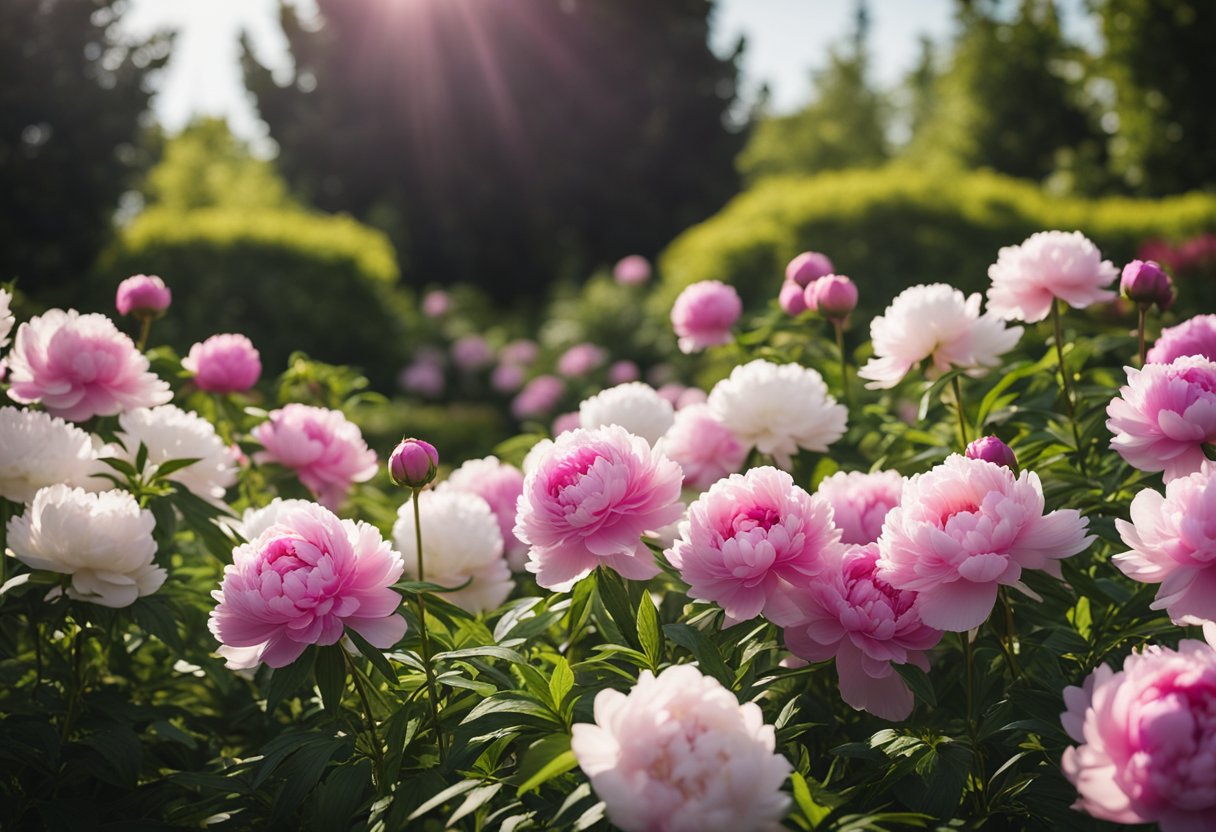
Peonies are hardy perennials that can bloom for decades with proper care. Here are some tips to help you care for your peonies and keep them blooming year after year.
Watering and Mulching
Peonies require regular watering, especially during their growing season. They prefer well-draining soil that is kept moist but not waterlogged. To ensure that your peonies get enough water, water deeply once a week, or more often during hot, dry weather.
Mulching can help retain moisture in the soil and regulate soil temperature. Apply a layer of organic mulch, such as shredded leaves or bark, around the base of your peonies in the spring. This will also help suppress weeds and keep the soil cool.
Fertilizing
Peonies benefit from regular fertilization to promote healthy growth and blooming. Apply a balanced, slow-release fertilizer in the spring, just as the new growth begins to emerge. Be careful not to over-fertilize, as this can lead to weak stems and foliage.
Pruning and Deadheading
Proper pruning and deadheading can help your peonies produce more blooms and stay healthy. Cut back the foliage to the ground in the fall after it has turned brown. This will help prevent the spread of disease and pests.
Deadhead spent blooms as soon as they begin to fade. This will encourage the plant to produce more flowers and prevent the plant from wasting energy on producing seeds. Cut the stem just above a healthy leaf or bud.
By following these simple care tips, you can enjoy beautiful, long-lasting blooms from your peonies for many years to come.
Pest and Disease Management
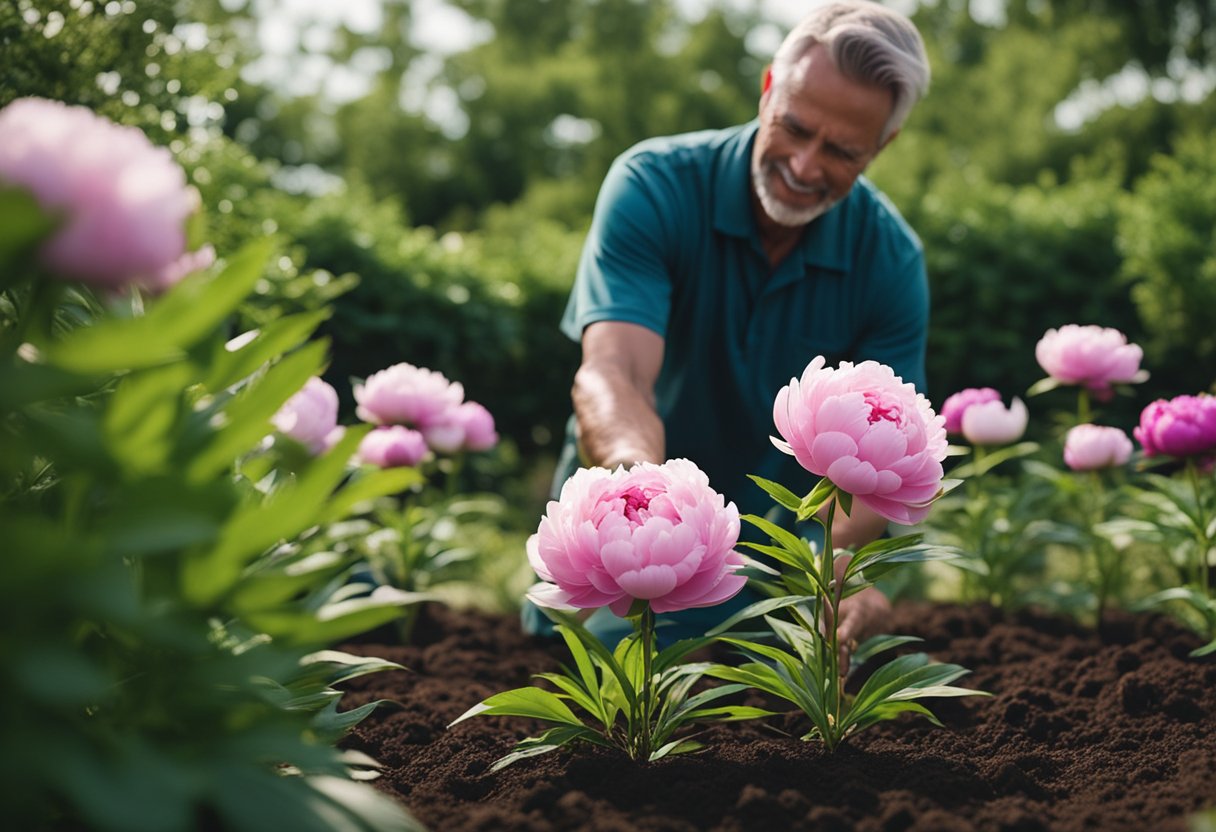
Common Pests
Peonies are generally resistant to pests, but there are a few insects that can cause damage to the plant. One of the most common pests is the peony borer, which is a type of moth that lays its eggs on the stems of the plant. The larvae then burrow into the stems and feed on the inside, causing the stems to weaken and eventually break. To prevent peony borers, it is important to remove all plant debris in the fall and to cut back the stems in the spring to remove any overwintering larvae. Insecticides can also be used to control peony borers.
Another common pest is the nematode, a microscopic worm that feeds on the roots of the plant. Nematodes can cause stunted growth and yellowing of the leaves. To prevent nematodes, it is important to plant peonies in well-draining soil and to avoid overwatering.
Disease Prevention and Treatment
Peonies can be susceptible to a few diseases, including botrytis blight, powdery mildew, and verticillium wilt. Botrytis blight is a fungal disease that causes brown spots on the leaves and flowers. To prevent botrytis blight, it is important to avoid overhead watering and to remove any infected plant debris. Fungicides can also be used to control the disease.
Powdery mildew is another fungal disease that can affect peonies. It causes a white powdery coating on the leaves and stems. To prevent powdery mildew, it is important to plant peonies in a location with good air circulation and to avoid overcrowding. Fungicides can also be used to control powdery mildew.
Verticillium wilt is a soil-borne fungal disease that causes the leaves to wilt and turn yellow. To prevent verticillium wilt, it is important to plant peonies in well-draining soil and to avoid overwatering. There is no cure for verticillium wilt, so infected plants should be removed and destroyed to prevent the disease from spreading.
By following these pest and disease management tips, you can ensure that your peonies will bloom for decades to come.
Encouraging Blooms
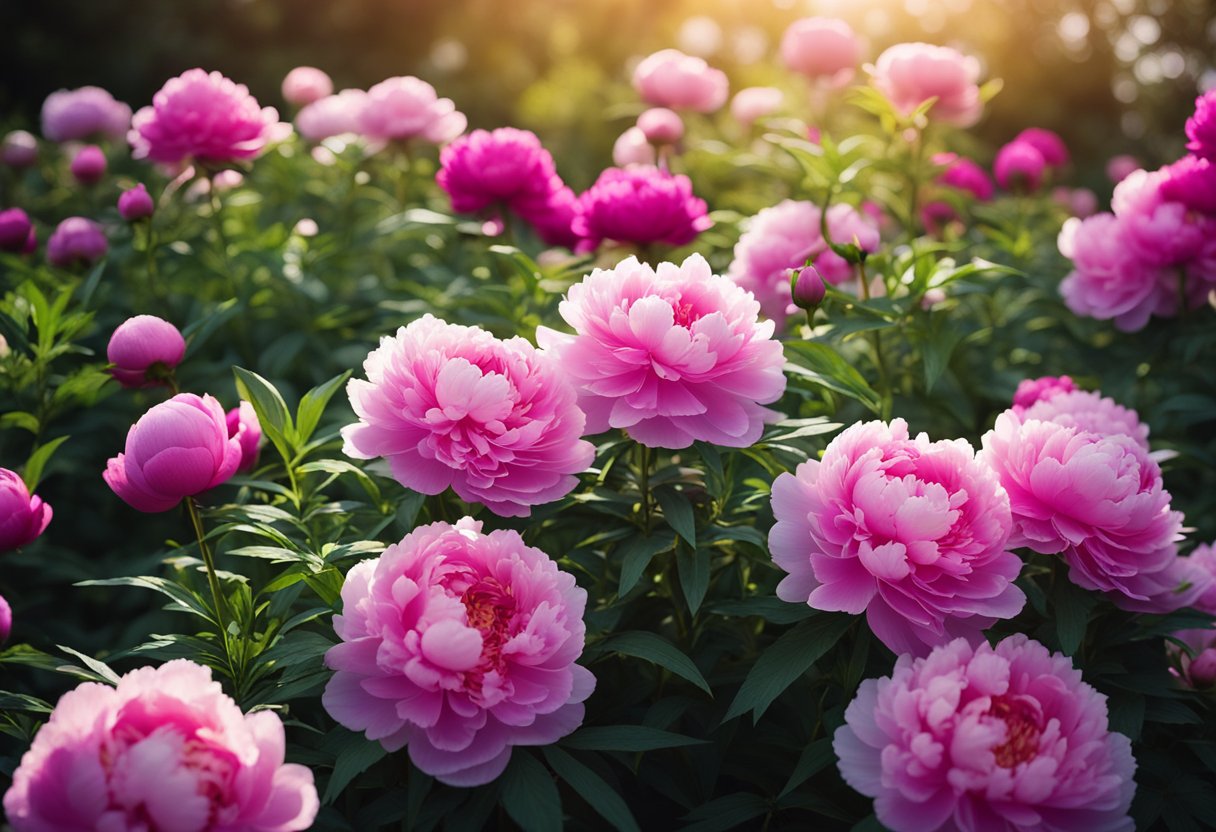
Sunlight and Blooming
Peonies require a lot of sunlight to bloom, so it is important to plant them in a location that receives at least six hours of direct sunlight each day. If your peonies are not getting enough sunlight, they may not bloom at all or the blooms may be smaller than usual.
It is also important to note that peonies do not like to be moved once they have been planted, so it is important to choose a location that will receive adequate sunlight for years to come.
Seasonal Care for Maximum Bloom
In order to encourage maximum blooms, it is important to provide the right care at the right time of year. Here are some tips for seasonal care:
- Spring: As soon as the ground thaws, remove any winter mulch and prune any dead or damaged branches. Fertilize with a balanced fertilizer and water thoroughly.
- Summer: Water your peonies deeply once a week, and deadhead spent blooms to encourage new growth. Avoid cutting back foliage until it has turned yellow in the fall.
- Fall: Cut back foliage once it has turned yellow and remove any debris from around the base of the plant to prevent disease. Mulch with a layer of compost or leaves to protect the roots during the winter.
By providing your peonies with the right amount of sunlight and seasonal care, you can encourage them to bloom for decades to come.
Winterizing Peonies

As winter approaches, it’s important to take steps to protect your peonies from the cold weather. With the right care, your peonies can continue to thrive and bloom for decades to come.
Protecting Plants in Winter
One of the most important steps in winterizing your peonies is to protect the plants from freezing temperatures. Here are some tips to help you keep your peonies safe during the winter months:
- Mulch: Adding a layer of mulch around the base of your peonies can help protect the plants from freezing temperatures. Use a layer of straw, leaves, or other organic material to insulate the soil and keep the roots warm.
- Cut Back: Before the first frost, cut back the stems of your peonies to about 2-3 inches above the ground. This will help prevent damage from heavy snow and ice.
- Cover: If you live in an area with particularly harsh winters, you may want to consider covering your peonies with a protective cloth or blanket. This can help keep the plants warm and protect them from freezing temperatures.
By taking these steps to winterize your peonies, you can help ensure that your plants will continue to thrive and bloom for years to come. With a little bit of care, your peonies can be a beautiful addition to your garden for decades.
Troubleshooting Common Issues

Non-Blooming Plants
If your peonies are not blooming, there could be a few reasons why. First, make sure they are getting enough sunlight. Peonies need at least 6 hours of direct sunlight per day to bloom. If they are not getting enough sunlight, consider moving them to a sunnier location.
Another reason your peonies may not be blooming is that they are too young. Peonies can take up to 3 years to mature and produce blooms. If your plants are still young, be patient and wait for them to mature.
Finally, if your peonies are not blooming, it could be due to over-fertilization. Too much nitrogen can cause peonies to produce lush foliage at the expense of blooms. Make sure you are not over-fertilizing your plants.
Yellowing Leaves
Yellowing leaves on peonies can be caused by a few different things. One common cause is over-watering. Peonies prefer well-draining soil, and too much water can lead to root rot and yellowing leaves. Make sure your peonies are planted in well-draining soil, and water them only when the top inch of soil is dry.
Another cause of yellowing leaves is a lack of nutrients. Peonies need regular fertilization to stay healthy and produce blooms. Make sure you are fertilizing your plants with a balanced fertilizer, and follow the instructions carefully.
Stem Weakness
If your peony stems are weak and falling over, it could be due to a lack of support. Peonies have heavy blooms, and their stems can become weak and floppy without support. Consider staking your plants to provide support for the stems.
Another reason for weak stems could be a lack of nutrients. Peonies need regular fertilization to stay healthy and strong. Make sure you are fertilizing your plants with a balanced fertilizer, and follow the instructions carefully.
Propagation and Breeding
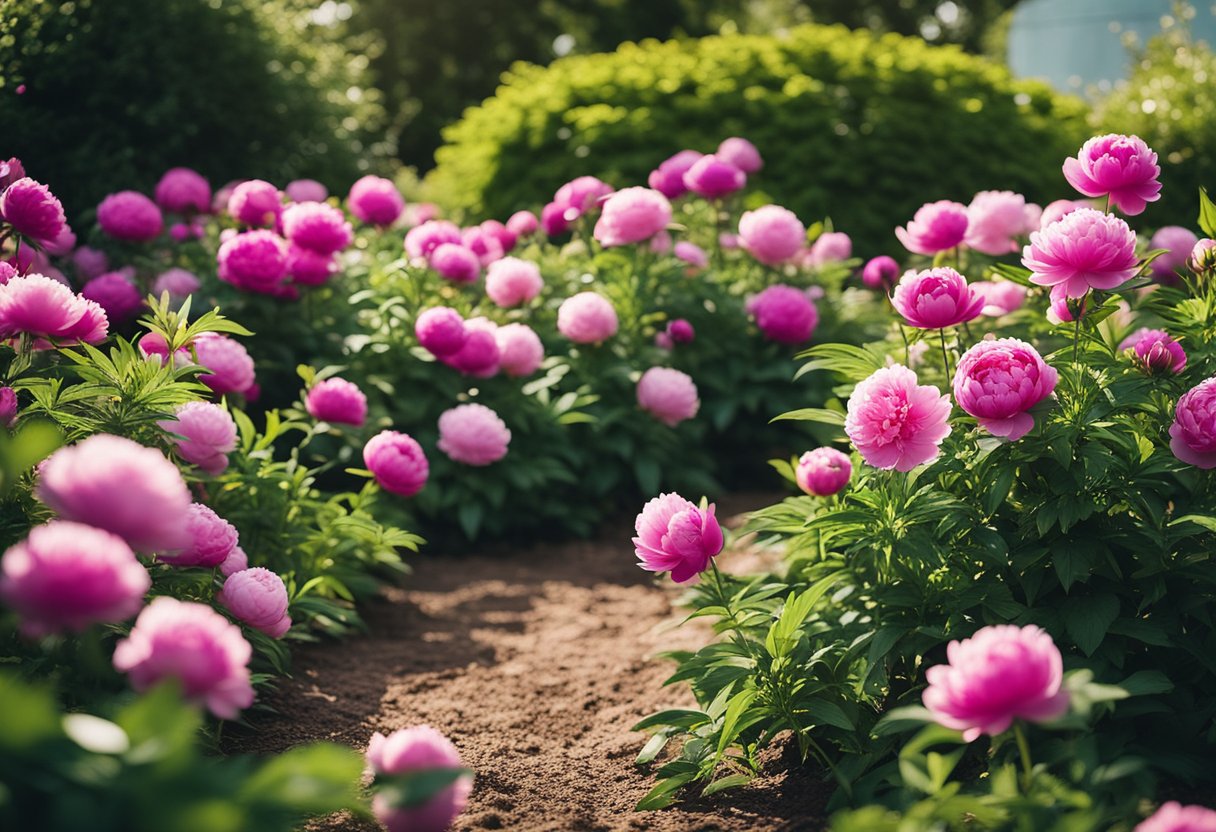
Seed Propagation
Peonies can be propagated from seeds, but it is a slow process and requires patience. The seeds should be sown in the fall, as soon as they are ripe, in a well-draining soil mix. The seeds should be sown at a depth of about 1 inch and kept moist. Germination can take up to two years, so it is important to be patient.
Once the seedlings have developed their first set of true leaves, they can be transplanted into individual pots. It is important to handle the seedlings carefully, as their roots are delicate. The seedlings should be grown in a cool and bright location, protected from direct sunlight.
It may take several years for the seedlings to develop into mature plants that are capable of blooming. However, seed-grown plants often produce unique and interesting variations that cannot be found in commercially available varieties.
Breeding New Varieties
Breeding peonies is a complex process that requires knowledge of genetics and plant breeding. It involves selecting desirable traits from different parent plants and crossing them to create new varieties.
One method of breeding peonies is by hand pollination. This involves transferring pollen from the stamen of one plant to the stigma of another. The resulting seeds will contain genetic material from both parent plants and will produce offspring with a combination of their traits.
It is important to select parent plants that have desirable traits, such as large or fragrant flowers, strong stems, and disease resistance. It may take several years of selective breeding to produce a new variety that meets all the desired criteria.
Overall, propagation and breeding are important techniques for creating and maintaining healthy and diverse peony populations. By using these methods, gardeners can enjoy beautiful and long-lasting blooms for decades to come.
Long-Term Care and Maintenance
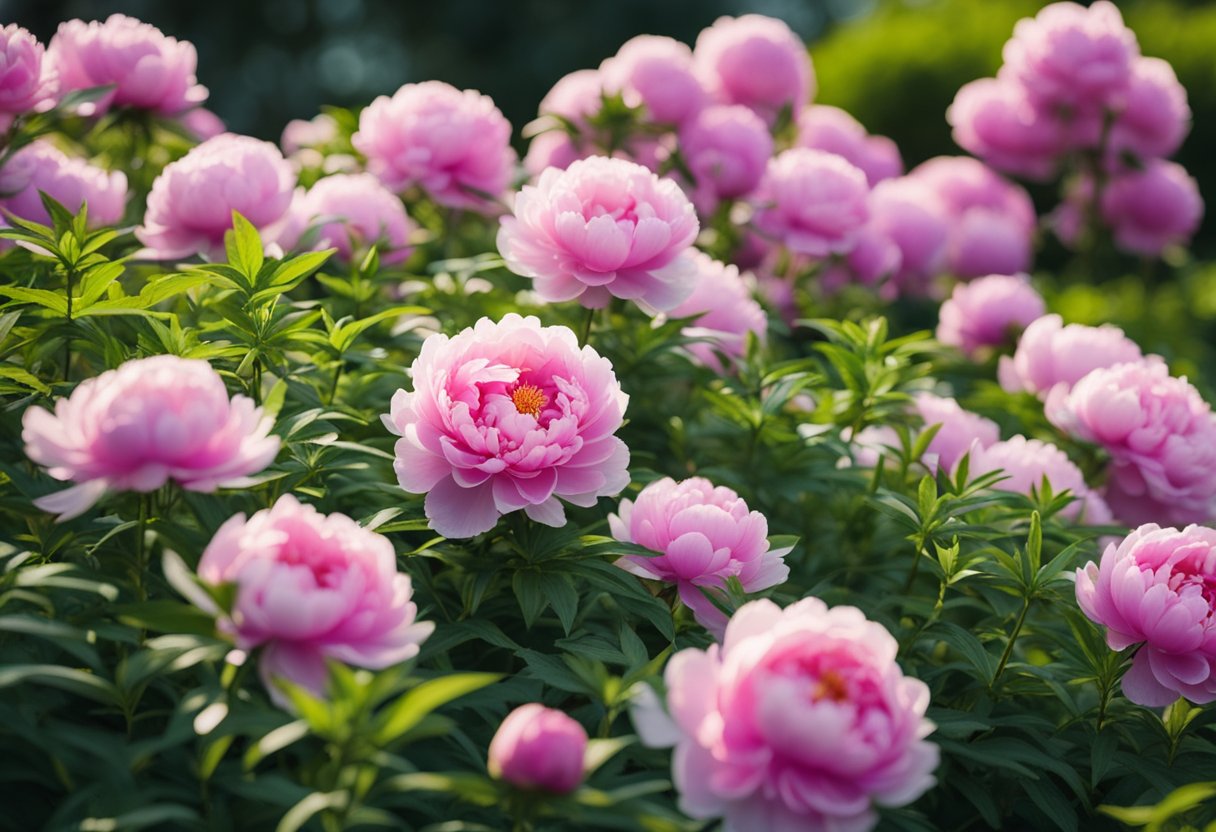
Rejuvenating Old Plants
Peonies are long-lived plants that can produce beautiful blooms for decades. However, as they age, their blooms may become smaller and less abundant. To rejuvenate old plants, I recommend dividing them every 5-7 years. This will help to promote new growth and improve the overall health of the plant.
To divide a peony, start by digging up the entire plant in the fall when it is dormant. Use a sharp knife to cut the plant into several sections, making sure that each section has at least one healthy bud. Replant each section in a new location, making sure to amend the soil with compost or other organic matter.
Transplanting and Space Management
Peonies prefer well-drained soil and full sun, but they can tolerate some shade. If you need to transplant a peony, do so in the fall when the plant is dormant. Dig up the entire plant, being careful not to damage the roots. Replant the peony in a new location, making sure to amend the soil with compost or other organic matter.
When planting peonies, it is important to give them enough space to grow. They should be planted at least 3 feet apart to allow for good air circulation. If your peonies become overcrowded, you may notice a decrease in bloom size and quantity. To prevent this, divide your plants every 5-7 years as mentioned above.
In addition to proper spacing, peonies also benefit from regular fertilization and watering. Apply a balanced fertilizer in the spring and water deeply once a week during dry spells. With proper care and maintenance, your peonies can bloom for decades and provide you with beautiful flowers year after year.
